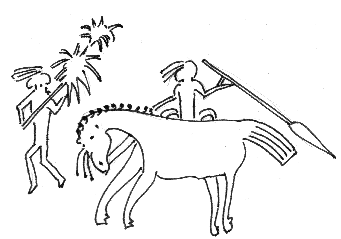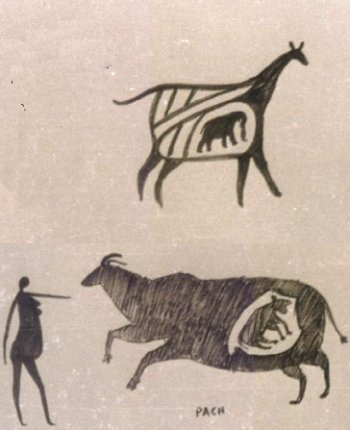|
| ||
|
|
||
|
|
||
|
|
||
|
|
||
|
|
||
by Dr. K. L. Kamat
Page Last Updated: June 09,2002
Prehistoric Cave Paintings of Bhimabetaka
Introduction | Artistic Merits
Picture Galley | Other
Prehistoric Art from India
Since the native man was not bound by any artistic constraints, the pictures come to life in full freedom and expression. The native man was an expert in simplifying life; he has drawn animals and birds with just two or three strokes. He has also made a good use of symbols and highlights, so a trunk denotes an elephant, a long feather represents a peacock, and a decorative horn illustrates a female deer. Some are single line sketches, and some are finished with a fair stroke. Some are really attractive with colors and shades.
© K. L. Kamat

Welcome to a Hero
The background of the rock paintings is obscure and is hard to photograph the paintings. Most of them have lost the sharpness and luster. Some are extremely fuzzy and ruined. I had to use special contrast film and filters to photograph them. I could have sprayed the water on them for better contrast, but the water with its alkaline contents damage the originals, and there was no way for me to carry chemicals and other gear to that remote location. I have taken the easy route out and have drawn the line drawings in this page based on my photographs. When compared to originals these pictures may look artificial, yet I hope that they resemble the originals as perceived by the original artists.
© K. L. Kamat

Imagination or Ignorance?
The ancient artists cared little for the details. Like the modern artists, it must have been the feeling to be conveyed was the most important for him. I also feel that he has done great injustice to the women of his time. Among the thousands of pictures, less than ten show women. In this aspect, the rock paintings of Bhimabetaka differ from the cave paintings of Spain which are about of the same period. Since the Spanish painters were desiring renewal of life, the sexes and the organs are given primary importance. Few Bhimabetaka paintings show sexual organs. Sometimes to identify a woman they have drawn a small vagina, but has left out the breasts. However, in some spots to glorify women they have drawn large breasts with fountains of milk coming out of them.
These rock paintings mirror the difficulties of the native man's struggle with life as also his accomplishments. You can see rock weaponry, bows, arrows, and then the knives. He wove baskets with bamboo and started climbing the trees. He learned how to weave a rope from tree bark and cloth from the fibers. He must have used fish bones as needle and trained dogs for hunting. About this time he also learned raising of birds for food.
As the civilization progressed there were fights among tribes. There are lots of pictures in Bhimabetaka which illustrates ferocious warfare among humans. Since there are no signs of horses in the neighborhood of Bhimabetaka, the ones in the picture were probably confiscated from raiding invaders.
© K. L. Kamat

Group dance
After the daily life became easier, the native man turned to dancing in music. There are pictures of group dance, mask dance, and stick dance. Although it's a common concept that the native man was naked, the artist has drawn clothes on all the dancers. It's possible that the clothing was unisex.
As a person who went to find the similarities between current day tribals and native tribals, I was dumbfounded by the similarities in their lifestyle. The tribals of Madhya Pradesh have lived monotonous lifestyles for thousands of years. Even today the Adivasis (aa-di-vaa-si, from Sanskrit, native) draw animals and birds on their walls consisting of triangles and circles for success in hunting. They also have unisex clothing, hunting with bows and arrows, and group dances. If someone studies the similarities between the two cultures, several generations of lost lifestyles may be uncovered.
![]()
Prehistoric Cave Paintings of Bhimabetaka
Introduction | Artistic Merits
Picture Galley | Other
Prehistoric Art from India
References
- Kamat K.L., The Timeless Theater CD-ROM, 1999 (Buy at Amazon)
- Brooks, R. and Wakankar V. S., Stone Age Painting in India, Yale, 1976
- Kamat K. L., KaalaRanga (in Kannada), Manohara Grintha Mala, 1982
- The Arts of India -- numerous art forms form Indian subcontinent
- Kamat PictureSearch Results for Cave Art
- Bastar Travelogue -- Life among tribals of Madhya Pradesh
- The Tribals of India
- Prehistoric Rock Paintings from Central India - Index
- Interview with Dr. Wakankar -- the man who discovered Bhimabetaka
|
|
|
|